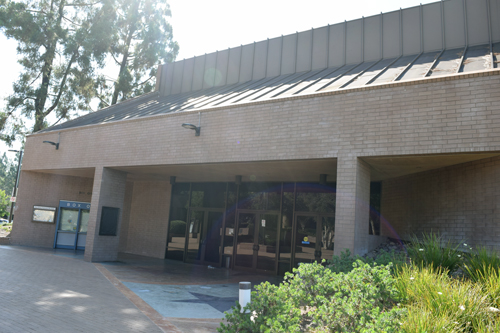
-49th in a Series —
Exit 17C, Magnolia Avenue, El Cajon ~ East County Performing Arts Center
By Donald H. Harrison
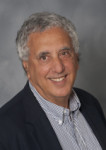
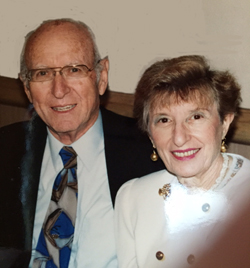
EL CAJON, California – The East County Performing Arts Center (ECPAC) was the glittering gem of downtown El Cajon’s “super block” when it hosted its inaugural performance on September 8, 1977. Many people gave Dr. Sydney Wiener, a retired dentist, credit for being that gem’s fine “jeweler.”
Wiener was a relatively young man when he retired from his dental practice and the energy that he once put into a career he poured into his appreciation for the arts. After arriving in El Cajon from New York with his wife Charlotte, they became involved in the Grossmont Community Concert Association, which advocated for a first-class auditorium in eastern San Diego County.
Not content just to talk about the idea, Wiener successfully ran for a seat on the Grossmont Community College Board (later to become the Grossmont-Cuyamaca Community College Board) which under an agreement approved by the electorate, became partners with the City of El Cajon in ECPAC’s construction and maintenance.
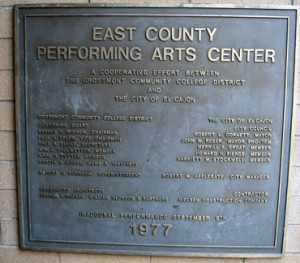 If there were a fundraiser to be put on for the nearly 1,142-seat auditorium, Wiener was among those organizing and contributing to it. If grants for the arts needed to be coaxed out of Washington D.C., Wiener was the one who jumped into his single engine Beechcraft Bonanza to meet with bureaucrats and elected officials. He also flew the plane as a volunteer rescue worker for the San Diego Sheriff’s Office.
If there were a fundraiser to be put on for the nearly 1,142-seat auditorium, Wiener was among those organizing and contributing to it. If grants for the arts needed to be coaxed out of Washington D.C., Wiener was the one who jumped into his single engine Beechcraft Bonanza to meet with bureaucrats and elected officials. He also flew the plane as a volunteer rescue worker for the San Diego Sheriff’s Office.
Wiener was proud of the acoustics at ECPAC, and said that the seating in 27 continuous rows, with no center aisle, made every patron feel that he or she had scored one of the best seats in the house.
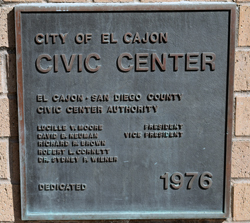 During 17 years of service as a community college trustee, Wiener was elected board president eight times. In that capacity, he not only served on the joint powers agency that created ECPAC, he also served on another joint power agency that oversaw development and construction of the El Cajon Civic Center, which sits across a plaza from ECPAC. The city of El Cajon and the County of San Diego were among the college district’s partners. The Civic Center complex includes El Cajon’s City Hall and a County Courthouse.
During 17 years of service as a community college trustee, Wiener was elected board president eight times. In that capacity, he not only served on the joint powers agency that created ECPAC, he also served on another joint power agency that oversaw development and construction of the El Cajon Civic Center, which sits across a plaza from ECPAC. The city of El Cajon and the County of San Diego were among the college district’s partners. The Civic Center complex includes El Cajon’s City Hall and a County Courthouse.
Not surprisingly, some people thought of Wiener both as Mr. Community College, and Mr. ECPAC. From his home in the Fletcher Hills neighborhood of El Cajon, he was just a short ride from Grossmont College. And he took pride in helping to create the second college in the district, Cuyamaca College, located in Rancho San Diego. When eventually, he was defeated for re-election, his shocked colleagues on the board voted to honor him as a “trustee emeritus” bringing him life-long invitations to district events.
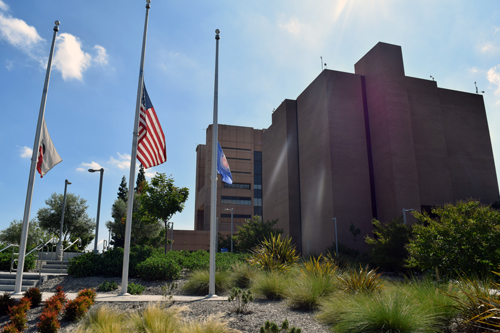
Wiener’s daughter, Laura Mills, today a clinical psychologist in Maple Bay, British Columbia, said music and culture were always revered components of her parents’ lives. When she and her sister, Barbara Hanawalt, were children Sundays typically meant an outing to a New York City museum. Laura played the viola, Barbara played the cello, and one summer their proud parents enrolled them both in the National Music Camp in Michigan.
“Our father enjoyed and valued culture, particularly music and the visual arts,” Mills said. “He loved listening to classical music. Our mother played the piano and had a beautiful singing voice. He greatly admired that. They ensured we learned how to play music. When asked if he played anything, Dad would say he played the record player!”
Hanawalt, who teaches visually impaired children in Portland, Oregon, suggested in an interview that her father’s interest in creating the ECPAC not only was cultural but also was technical.
She explained: “When he was a young child, his parents bought a player piano for his older sister. He loved to listen to the music from that. Years later he recalled how the piano had to be hoisted up on ropes because his family lived on the 5th floor of a six-story walk-up in what is today Spanish Harlem in Manhattan. No elevator! He also recalled the many opera melodies and classical music themes he absorbed from the music on the piano rolls. This was the start of his interest in music.”
When the drive began to build ECPAC, Hanawalt recalled, “he was interested in creating a building with good acoustics. He and our mother enjoyed going to concerts and the opera in New York, and Dad had an ear for good sound in a concert hall.”
In that he was a pilot, Weiner “saw his involvement with building the Performing Arts Center as an opportunity to go places in the plane to visit different halls and experience their acoustics,” his daughter said. “He and mom took a trip to Roseburg, Oregon, to the community college there because that school had an auditorium known for its good acoustics. They went to Seattle to meet acoustics expert Paul Veneklasen, and were pleased to have his input. Also, Dad liked the world of finance, so raising the funds to build the Performing Arts Center was fun for him in its own way. He liked putting together the bond funding for it. He consulted with lots of people about the acoustics of the new hall, including my father-in-law, Clare Hanawalt, who was the chief engineer at KGW TV in Portland.”
Stan Flandi, who capped a 33 year career at Grossmont College as the dean of its evening division, recalled “Dr Wiener,” as he always called him, with fondness. “He was a professional person, a dentist, a fun-loving kind of guy, always smiling and laughing,” Flandi said. “He always looked for the positive and not the negative. I have a lot of respect for him and what he tried to do for the arts in the East County.”
Del Hood, the retired longtime reporter and editor of the now defunct Daily Californian, said he admired Wiener because “he was pro-education doing what he thought needed to be done for the college district and sustaining ECPAC as long as he could. He was a good guy who had the best interests of the college district at heart.”
When Wiener died in 1995 at age 76, after 50 years of marriage to Charlotte, he was eulogized by Rabbi Leonard Rosenthal of Tifereth Israel Synagogue as a “modern-day Renaissance man,” who invested all his projects “with his characteristic verve and enthusiasm.”
Wiener’s other interests, Rosenthal noted, included collecting old Edison phonographs that he was “expert at repairing and restoring.” He proudly displayed them at his home along with a fine collection of art works that he and Charlotte had collected, and photographs that Wiener himself had taken on his trips with his wife to many countries all over the world. Charlotte lived nearly 20 years longer than her husband.
Unfortunately Wiener’s enthusiasm for culture could not be mass-cloned. Filling up a large auditorium far from San Diego’s downtown cultural center was not easy. A Google review of productions prior to 2010, when the facility was shuttered, indicated that operators did their best to bring a variety of offerings to the East County public.
For example, ECPAC had musical programs such as a Patti LuPone concert in 2003, Steve Lawrence & Edye Gorme in 2005, and a “Mozart mania” program bringing together the Grossmont Symphony Orchestra, Helix Charter High School Advanced Choir and String Orchestra and the San Diego Children’s Chorus in 2006. Stage productions included Little Shop of Horrors in 1987 and a revival of Thoroughly Modern Millie in 2008. Among dance programs was an exhibition of csardas, “the tango of the east,” staged by the Budapest Ensemble from Hungary. There were also community gatherings, such as a large fundraiser in 2004 for SPRITES, a mother-daughter organization that focuses on volunteering. And for the Jewish High Holy Days, the East County Performing Arts Center annually served as the venue for the Reform services of Temple Emanu-El.
But the Center had major problems during economic hard times. Rather than being a revenue source, ECPAC meant expenditures for the Grossmont-Cuyamaca Community College District. Flandi said that “supporting ECPAC became a drag on the district’s budget.” Why did ECPAC struggle so? “In some cases ECPAC was too big for some types of performances and in other cases it was too small,” Flandi said. “Critics always talked about insufficient fly space, the area in the back for staging and scenery. So there were some problems with the ECPAC.”
Editor Hood said initially the community college district and the city of El Cajon, acting as a joint powers agency, had the right to impose a “community service tax” to finance ECPAC, but when that right was repealed, ECPAC began to struggle. The development of Indian gaming casinos, offering fine entertainment at low ticket prices, added to ECPAC’s financial woes, Hood said.
Eventually the college district relinquished its ownership of ECPAC to the City of El Cajon, which in a cost-saving move later shuttered the facility. If Syd Wiener were alive to see what had happened to ECPAC, “I think he would have been heart-broken,” said Flandi. “He was the advocate for it; he was really in support of it. He thought it would be best for the community, a source for the arts in East County. Yes, we have the arts in San Diego, but, hey, this is El Cajon. We need some place for the performing arts.”
In 2015, efforts to revive ECPAC, which needs some physical repairs including new roofing, led to leasing the facility on Sundays and one weekday evening to the Rock Church, a non-denominational Christian megachurch.
*
Harrison is editor of San Diego Jewish World. You may comment to him at donald.harrison@sdjewishworld.com